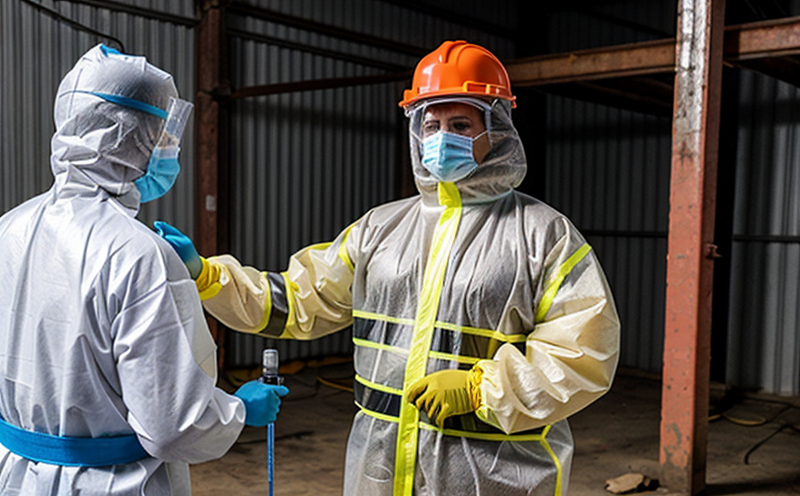Protective clothing compliance inspection
In the realm of food safety and hygiene, protective clothing plays a critical role in safeguarding both consumers and workers. The integrity of this barrier is paramount to prevent contamination from microorganisms, harmful chemicals, and physical hazards that could compromise product quality and public health.
The need for compliance with relevant standards ensures that the garments used by personnel in food processing environments meet specific criteria designed to protect against these risks. Compliance inspections are essential because they verify that the protective clothing not only meets but exceeds regulatory requirements, thereby enhancing overall safety protocols within facilities.
These inspections typically involve several key steps which include initial assessment of the garment design and materials used, followed by detailed examination under controlled conditions simulating real-world scenarios encountered during use. This process ensures that any potential vulnerabilities are identified early on so they can be addressed promptly before being deployed in operational settings where failures could lead to significant consequences.
The importance of such inspections cannot be overstated as they form an integral part of maintaining high standards across all aspects related to food safety and hygiene practices within the industry. By conducting regular checks, organizations demonstrate their commitment towards protecting public health while also ensuring compliance with applicable regulations set forth by governing bodies like FDA (Food & Drug Administration) or BRC (British Retail Consortium).
Understanding how protective clothing fits into broader food safety strategies is crucial for those involved in quality management, compliance oversight, research and development (R&D), as well as procurement activities. It underscores the necessity of rigorous testing procedures aimed at identifying any shortcomings early on so necessary adjustments can be made to maintain top-notch protection levels.
Why It Matters
The significance of protecting workers who interact directly with food cannot be overstated. Contaminants like bacteria, viruses, and allergens can easily transfer from the environment into products if proper precautions are not taken during production processes. Protective clothing acts as a first line of defense against such threats by creating an impermeable barrier between individuals and potential hazards.
However, simply having protective garments available is insufficient; they must also comply with stringent standards that guarantee their effectiveness over time. Regular inspections ensure that these items remain up-to-date with changing requirements and technological advancements, thus providing reliable protection against emerging risks.
Failing to adhere strictly to prescribed guidelines could result in compromised hygiene practices which might lead to product recalls or even legal action against responsible parties. Therefore, conducting thorough compliance inspections is not just advisable but mandatory for maintaining trust among customers and stakeholders alike.
Applied Standards
The International Organization for Standardization (ISO) has established several guidelines specifically addressing protective clothing used in various industries including food safety and hygiene. One such standard is ISO 16703:2015 which provides requirements for protective gloves intended to protect against mechanical hazards. Another relevant document is EN ISO 14116:2015 dealing with personal protective equipment (PPE) designed to offer protection from chemical splashes.
For clothing items worn by personnel involved in food processing, adherence to these international norms ensures that the garments possess qualities necessary for effective performance. These may include resistance against heat, chemicals, cuts, and punctures among others. Additionally, ISO 15684:2013 focuses on face masks used during surgical procedures but its principles can be adapted for similar applications in food safety contexts.
It is important to note that compliance with these standards does not guarantee absolute protection; rather it serves as a benchmark against which manufacturers and users alike can evaluate the adequacy of their protective measures. Ongoing vigilance through regular inspections helps maintain this standard throughout an item’s lifecycle, ensuring continuous improvement where needed.
Use Cases and Application Examples
- Bakery Operations: Workers handling raw dough may wear gloves that comply with ISO 16703:2015 to avoid transferring contaminants onto finished products.
- Slaughterhouses: Employees dealing with meat must use protective gear like boots and aprons that meet EN ISO 14116:2015 specifications to protect themselves from bloodborne pathogens while also preventing contamination of the product.
- Dairy Farms: Milk handlers should wear coveralls designed per ISO standards to keep bacteria at bay during collection activities.
- Canning Plants: Personnel involved in filling jars with preserves need garments resistant to acidic environments as specified by relevant international norms.
In each case, ensuring that protective clothing complies with appropriate regulations is vital for preventing cross-contamination and maintaining sanitary conditions within the facility. Regular inspections help identify any issues early on so they can be addressed promptly before causing harm or compromising product integrity.





